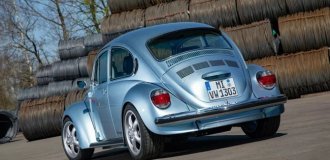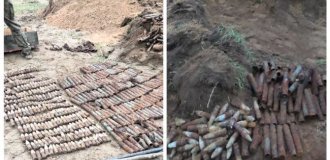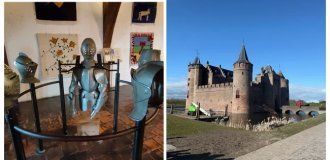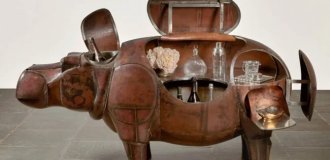About grenades and grenadiers (7 photos)
Ancient documents report that “the miasma of quicklime flowing from the pots, when they break, crushes and suffocates the enemy and his soldiers are upset.” The choice of material from which the grenades were made was determined mainly by the consideration that the vessels were supposed to break into small pieces when falling and scatter their contents as far as possible.

In Europe, the first mentions of exploding shells, which were thrown by hand into enemy concentrations and hit them with fragments and fire, date back to the 13th–15th centuries. Count Solms, in his work “Review of Military Affairs,” dating back to 1559, writes: “A round ball of burnt clay of considerable thickness, filled with gunpowder, breaks strongly and gives a strong blow. If you make it from thin material, it breaks easily and gives a weak blow. Such a ball should have a long thin neck. It must be filled with seed gunpowder (pulp), tightly packed into the neck to slow down the burning, and tinder, which, slowly burning, reaches the seed gunpowder. In addition, the ball at the neck must have two ears. Through them you need to thread a piece of rope with a knot at the end. It is convenient to throw such a ball away from you into the enemy crowd. When the fire reaches the seed, the ball explodes and hits far around itself.”
Glass grenade
The 16th-century gunsmith Sebastian Gele from Salzburg, in one of his works, was the first to call explosive balls pomegranates or granadines, apparently by analogy with the fruits of the pomegranate tree, which, falling to the ground, scatter their seeds far.
He proposed making grenades from copper, iron, wood, glass, clay and even coated linen. Wooden and cloth balls needed to be coated with a layer of wax, bullets pressed into it, and then coated with wax again. The following is said about equipping grenades: “Fill the ball halfway with gunpowder and shake it well, then put in a few ounces of mercury and pour gunpowder again to completely fill the ball, finally insert the primer with flint into the ignition hole.”
Another recipe recommends adding bullets in addition to mercury. The significance of mercury here is unclear. However, another author, Wilhelm Dillich, in his work “Kriegsschule” dating back to 1689, indicates a similar method for making grenades. The clay body of the grenade was filled with black powder (1 pound), mercury (1 lot) and iron bullets. The wick was tinder placed in the seed hole.

Glass grenade
The 16th-century gunsmith Sebastian Gele from Salzburg, in one of his works, was the first to call explosive balls pomegranates or granadines, apparently by analogy with the fruits of the pomegranate tree, which, falling to the ground, scatter their seeds far.
He proposed making grenades from copper, iron, wood, glass, clay and even coated linen. Wooden and cloth balls needed to be coated with a layer of wax, bullets pressed into it, and then coated with wax again. The following is said about equipping grenades: “Fill the ball halfway with gunpowder and shake it well, then put in a few ounces of mercury and pour gunpowder again to completely fill the ball, finally insert the primer with flint into the ignition hole.”
Another recipe recommends adding bullets in addition to mercury. The significance of mercury here is unclear. However, another author, Wilhelm Dillich, in his work “Kriegsschule” dating back to 1689, indicates a similar method for making grenades. The clay body of the grenade was filled with black powder (1 pound), mercury (1 lot) and iron bullets. The wick was tinder placed in the seed hole.

In 1670, the first grenadier squad was formed in France, consisting of soldiers trained in the use of grenades. The detachment was made up of volunteers who had combat experience in storming and defending cities. In addition, only one type of grenade was accepted into service with this detachment. By 1672, such detachments were already in 30 regiments, and a few years later, in all regiments of the French army. In 1674, a detachment of mounted grenadiers appeared in France.
K. William writes in his book “The History of Firearms. From ancient times to the 20th century": "...In 1678 John Evelyn visited the army encamped on Hunslow Moor, and saw an innovation there: "... a new breed of soldiers, called grenadiers, who are skilled in throwing hand grenades, which everyone has full bag. Their hats are fur with a copper top, just like those of the Janissaries, which is why they look very fierce, and others have long caps hanging at the back.”

Austrian grenadiers
In Prussia at the end of the 17th century, each guards company included 10-12 grenadiers, who stood on the right flank of the battalion in battle formation. In 1698, an additional grenadier battalion of five companies was created, with 100 people in each company.
The beginning of the 18th century was a golden time for grenadiers. Grenadier units appear in all armies of the world. But by the beginning of the next century, with the development of firearms, the grenadier units were turning into a branch of the army, which was selective in its composition, but did not differ from the rest of the infantry in terms of armament.
In Austria, each company of an infantry regiment had 8 grenadiers. Later, two grenadier companies were created in each infantry regiment. These companies existed until 1804. The grenadiers had weapons and equipment that did not differ from those of other soldiers, but additionally carried three grenades in a bag. Large, physically strong people were recruited into these companies, with preference given to people with a “terrible” appearance.

Russian grenadier of the early 18th century
Grenadier units in Russia
In Russia, hand grenades began to be used at the end of the 17th century. Around the same time, the first units of grenadiers appeared. In 1679, during the campaign to Kyiv, the convoy of Colonel Kravkov’s regiment carried materials for the manufacture of hand grenades.
Before the Crimean Campaign, General Gordon proposed to have one company of grenadiers in each infantry regiment, training the most dexterous, strong and intelligent soldiers to use grenades. There is a written mention that the regiments of Gordon and Lefort set out on a campaign to Kozhukhovo, each containing one grenadier company. At the same time, grenadier teams appeared in the Preobrazhensky and Semenovsky regiments. After the first campaign against Azov (1695), these teams were consolidated into separate companies. Grenadiers appeared in the Streltsy regiments during the second Azov campaign (1696). After 1699, grenadier companies were established in only 9 infantry regiments formed by Prince Repnin.

In 1704, on the recommendation of Field Marshal Ogilvy, grenadier companies were organized in all infantry and cavalry regiments. By order of Peter I, the companies were composed of “selected people.”
By 1709, all infantry regiments already had such a company in their composition. Each company had three officers, 7 non-commissioned officers and 132 soldiers. Four years later, the grenadier companies were expelled from the regiments and consolidated into five grenadier regiments. Each such regiment had two battalions. At the same time, the first horse-grenadier regiments were created. It is curious that these companies did not lose contact with their “native” units, and were considered to be on a long trip, receiving all their allowances from their regiments. After the death of Peter I, the importance of the grenadiers began to gradually decline.
The grenadier regiments were renamed musketeer regiments and one grenadier company was left in them. In 1731, these companies were also disbanded, distributing the grenadier to the musketeer companies of 16 people each. In 1753, grenadier companies appeared again - there was now one per battalion. Three years later they were again organized into regiments. In 1811, these regiments were consolidated into divisions, and in 1814, the divisions were consolidated into a corps.
Development and use of hand grenades in the second half of the 19th century
By the middle of the 19th century, hand grenades turned primarily into serf weapons, used
when repelling an attacking enemy. In Russia, when supplying fortresses with grenades, they were guided by the following standards: for every 30 fathoms of the defense line, 50 grenades were provided. For every 100 grenades, 120 fuses and 6 bracelets were released. Throwing grenades at the enemy was carried out by crews of three people. The first number threw grenades, the 2nd loaded them, the 3rd brought ammunition. This calculation consumed up to 10 grenades per minute. In addition, grenades could roll off the shafts along pre-prepared chutes.
In Sevastopol, hand grenades were used little, due to the insignificance of their reserves. During the war, only 1,200 glass grenades intended for boarding battles were found in the Sevastopol arsenals. According to the report of Admiral Kornilov dated March 15, 1854, these grenades were transferred to coastal fortifications. According to the memoirs of a contemporary, many Frenchmen died during the storming of the bastions from these grenades.
Naturally, these small reserves did not last long for the defenders of Sevastopol. Here is an excerpt from the memoirs of a participant in those events, retired guard colonel Georgy Chaplinsky, regarding the defense of Malakhov Kurgan: “...Despite the strong grapeshot fire with which they were met, the French had already managed to climb onto the parapet, but the rangers of the Podolsk regiment and the Kursk militia squad managed to throw them off in the ditch Hit by rifle fire and stones, the surviving French fled into nearby trenches and craters that emerged from the camouflettes memorable to all...”
Please note - the enemy is below, in the ditch, and there is nothing to hit him with. They shoot him with guns and throw stones at him! Similar situations are repeatedly described in the memoirs of veterans. With the required number of hand grenades, much more damage could be inflicted on the enemy here.

General view and structure of a 3-pound hand grenade
And here are a few more examples from the memories of Sevastopol residents: “...small enemy hand grenades were placed in five-pound mortars in a cylindrical tin box, so that they would all fly out together and, when they fell at the work site, would do great harm to the workers...”.
The enemy did the same: “... halfway through the siege, the enemy began to throw baskets filled with grenades, numbering from fifteen to twenty, at us from mortars, mainly into the trenches. At night, the fall of these grenades was especially beautiful: having risen to a certain height, they disintegrated in all directions like a fiery bouquet...” Or here’s another: “...and our powder keg will be filled with enemy hand grenades, sometimes collected fragments and lying enemy cannonballs; a barrel with this gift will be put in a mortar and sent, in revenge, to the enemy: they say, the French will choke on their own goods...” “...A hand grenade is often thrown back into the enemy trench by hand. This was not difficult, since in some places the enemy aproshes at the end of the siege came very close, about sixty paces, no more ... " Considering the shortage of own grenades in Sevastopol, we are apparently talking about captured and unexploded French hand grenades of the 1847 model.
After the end of the war, it was time to sum up the sad results. It was necessary to rearm the army in accordance with the requirements of the time. Among other things, the changes also affected pomegranates.
In 1856, by order of the artillery, all fuses ignited from the wick were replaced with grating fuses. In the same year, the head of the Caucasian artillery Meyer received the task of creating prototypes of grenades in the Tiflis laboratory and testing them. Meyer's report was presented in 1858. In this report, the design of all fuses in service was considered unsatisfactory. At the same time, a description of the fuse and grenade created by Lieutenant Kazarinov was attached. After improving this fuse and increasing the charge of the grenade, it was put into service in 1863.
The fuse adopted for service had a tube body made of hard wood. The tube channel was tightly packed with gunpowder for 3 seconds of burning. The grinding mechanism consisted of two brass tweezers with notches, inserting one into the other. Their contacting surfaces were coated with a mixture of Berthollet salt and sulfur. To ensure tightness, the tube was coated with a special varnish and wrapped with canvas tape impregnated with a water-repellent composition. The grenade body was made of cast iron and had a spherical shape. A charge of black powder weighing 15-16 spools (60-65 grams) was placed inside the case. The leather bracelet had a carabiner for hooking the grater ring. This grenade was adopted as the 3-pound hand grenade.
Grenades stored in warehouses and arsenals failed due to moisture. The fuses became dangerous due to frequent shots from the retarding composition. In addition, a design flaw was revealed. Some grenades had fuses made of too hard metal, with blunt teeth. This led to the fact that after the grenade was thrown, it remained hanging on the bracelet with the fuse already burning.
To assess the merits of hand grenades in service, the Artillery Committee in October 1895 invited the fortress artillery “... to conduct practice with 3-pound hand grenades with a charge of 15 spools...”. The chief of artillery of the Vyborg fortress was the first to respond, probably due to proximity. He asked not to conduct such classes, as it poses a danger to those throwing. Having considered the request, the committee decided not to conduct classes in the Vyborg fortress and to wait for information from other fortresses.
In 1896, the Artillery Committee ordered the withdrawal of hand grenades from use “... in view of the emergence of more advanced means of destroying the enemy, the strengthening of the defense of fortresses in ditches and the unsafety of hand grenades for the defenders themselves...”.





















